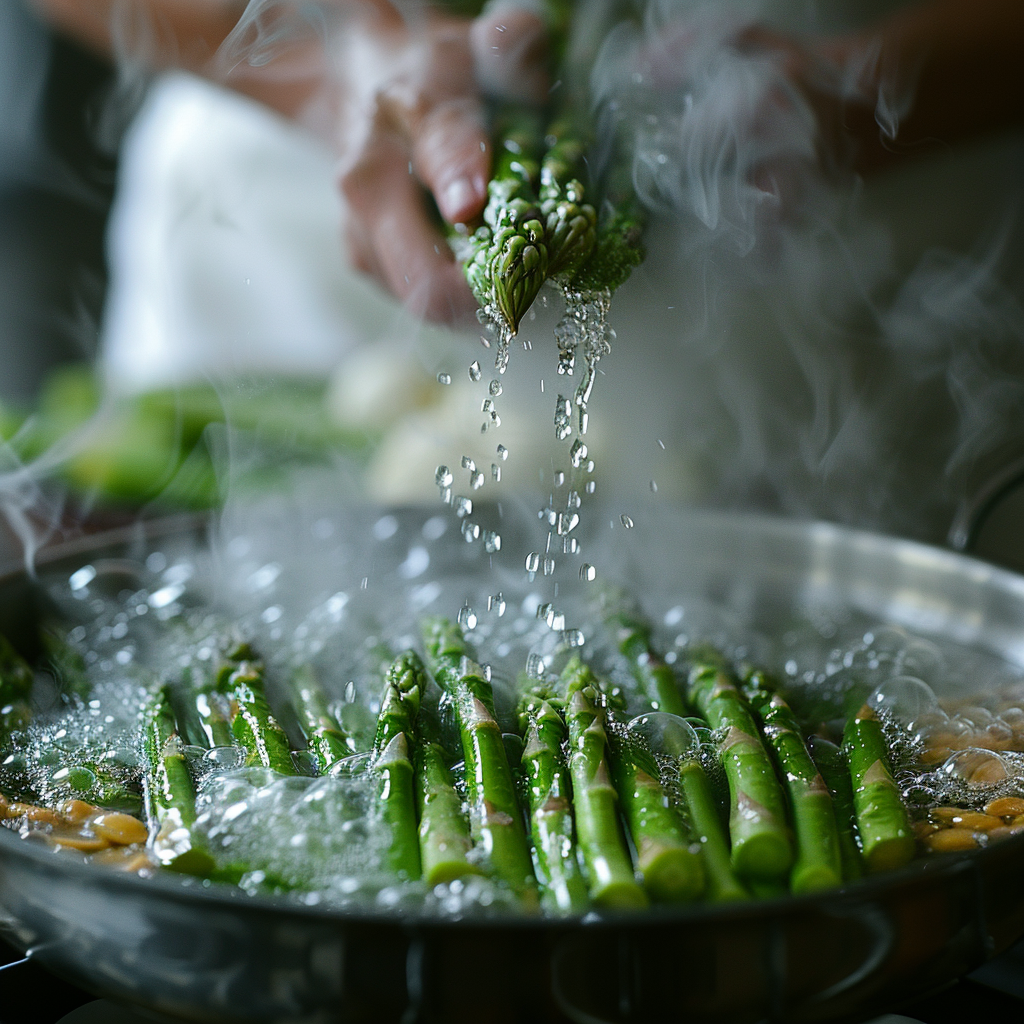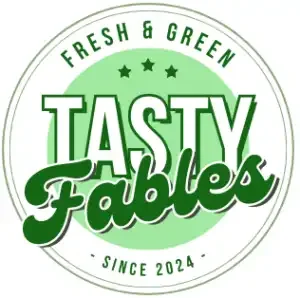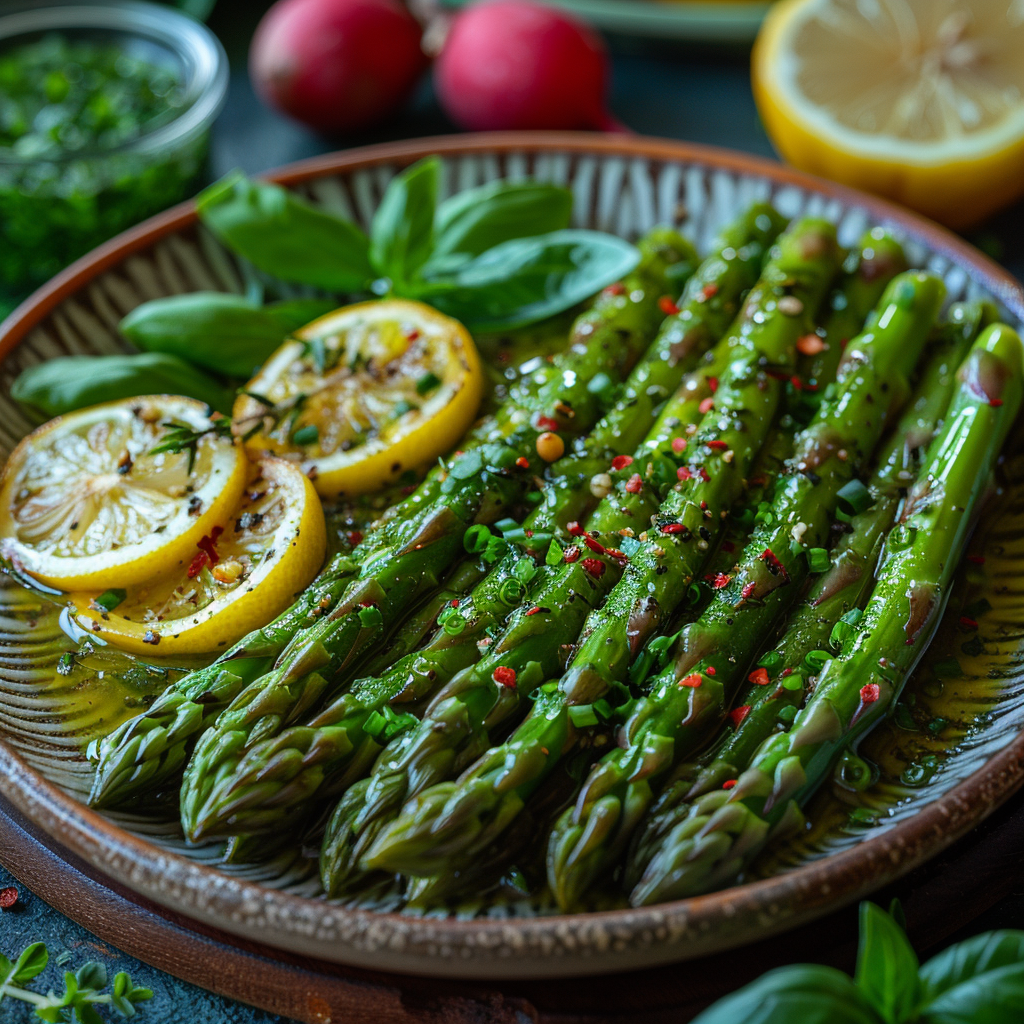Introduction: Why do you shock asparagus
Cooking vegetables can be a delicate art, and asparagus is no exception. One of the most debated techniques in culinary circles is shocking asparagus. This method, involving blanching the vegetable and then plunging it into an ice bath, may seem straightforward. However, its benefits for preserving color, texture, and nutrients are profound. Throughout this article, we’ll delve into why shocking asparagus is essential, how it works, and its impact on your dishes. So, whether you’re a home cook or an aspiring chef, these insights will elevate your asparagus game!
Part 1: Understanding Shocking in Cooking.Why do you shock asparagus
What Is Shocking Asparagus?
Shocking asparagus involves quickly cooling the stalks after blanching them in boiling water. This method stops the cooking process abruptly, ensuring that the asparagus retains its vibrant green color, crisp-tender texture, and fresh flavor. The secret lies in plunging the hot asparagus directly into an ice bath, halting the heat from continuing to soften the vegetable.
The Origins of Shocking Asparagus
Shocking vegetables, including asparagus, dates back to traditional European kitchens where maintaining food aesthetics was paramount. French chefs, for instance, embraced blanching and shocking to preserve the visual appeal of green vegetables. Over time, this technique became a culinary staple worldwide due to its ability to combine practicality and elegance in food preparation.
How Does Shocking Work?
The process of shocking asparagus rests on the principle of enzyme activity. When exposed to heat, certain enzymes in asparagus break down its natural pigments and nutrients. Without immediate cooling, these enzymes continue degrading the asparagus, resulting in a dull appearance and mushy texture. By introducing an ice bath, this degradation is interrupted, locking in the asparagus’s natural qualities.
Why Should You Shock Asparagus?
There are several compelling reasons to use this technique. First, shocking asparagus enhances its appearance, making it a feast for the eyes. Second, it optimizes texture, ensuring that the asparagus is neither too firm nor overly soft. Finally, it retains a substantial amount of its vitamins and antioxidants, making it as healthy as it is delicious.
Part 2: The Science Behind Shocking Asparagus.Why do you shock asparagus

The Role of Heat and Enzymes
When asparagus is exposed to boiling water, enzymes like chlorophyllase and polyphenol oxidase begin to break down its natural pigments and compounds. These enzymes are responsible for the browning or dulling effect seen in vegetables that are overcooked. By quickly cooling asparagus, you stop these reactions in their tracks, preserving its vibrant green hue.
The science is simple but fascinating. Heat softens the cell walls of asparagus, which is essential for its texture. However, if the heat isn’t stopped at the right moment, it leads to over-softening. The ice bath ensures this perfect balance.
How Water Temperature Impacts Texture
Water temperature plays a pivotal role in blanching and shocking. Boiling water ensures that the asparagus is cooked evenly, while the ice bath shocks it to prevent further cooking. This temperature contrast is crucial. Without it, the asparagus continues to cook from residual heat, risking a mushy texture.
Nutrient Retention Through Shocking
Interestingly, shocking asparagus preserves its nutrients. Vitamins like vitamin C and antioxidants such as glutathione are sensitive to prolonged heat exposure. By halting the cooking process immediately, shocking keeps these nutrients intact, giving you a healthier plate.
Part 3: Benefits of Shocking Asparagus.Why do you shock asparagus
Retains Vibrant Green Color
One of the most noticeable benefits of shocking asparagus is its ability to maintain a vivid green hue. Asparagus naturally contains chlorophyll, which is responsible for its color. When exposed to boiling water, chlorophyll becomes more vivid. However, without shocking, the color fades as the heat continues to work on the vegetable. An ice bath locks in this bright color, making your dishes visually appealing.
Preserves Crisp-Tender Texture
Texture is crucial in cooking asparagus. Overcooked asparagus becomes limp and mushy, losing its signature snap. Shocking stops this degradation by halting the cooking process. The result? Perfectly crisp-tender asparagus that’s ideal for grilling, sautéing, or tossing into a salad.
Enhances Nutritional Value
By preserving heat-sensitive vitamins and antioxidants, shocking asparagus makes your meals not only delicious but also nutritious. Nutrients like folate, vitamin K, and vitamin C are better retained in vegetables that undergo blanching and shocking compared to those cooked without these techniques.
Part 4: Step-by-Step Guide to Shocking Asparagus.Why do you shock asparagus
Selecting Fresh Asparagus
The success of shocking begins with the asparagus you choose. Look for firm, bright green stalks with tightly closed tips. Avoid asparagus that appears wilted or has soft spots, as these are signs of aging.
Blanching Process: Time and Temperature
- Prepare Your Tools: Gather a large pot for boiling water and a bowl filled with ice water. Add salt to the boiling water for flavor.
- Trim the Asparagus: Snap off the woody ends of the stalks.
- Blanch the Stalks: Drop the asparagus into the boiling water. Cook for 2-3 minutes, depending on the thickness of the stalks. For thinner stalks, reduce the time to 1-2 minutes.
- Remove Promptly: Using tongs or a slotted spoon, quickly transfer the asparagus to the prepared ice bath.
Immediate Ice Bath: Techniques and Tips
- Ensure Enough Ice: The water must remain cold to stop the cooking process effectively.
- Submerge Completely: Make sure all stalks are fully submerged for even cooling.
- Monitor the Time: Keep the asparagus in the ice bath for the same duration as blanching, approximately 2-3 minutes.
Part 5: Common Mistakes to Avoid.Why do you shock asparagus
Overcooking During Blanching
Blanching asparagus for too long can ruin the texture, leaving it soft and mushy. Always keep a timer handy and adjust blanching time based on the stalks’ thickness.
Insufficient Cooling Time
Not leaving the asparagus in the ice bath long enough allows residual heat to continue cooking it. Ensure that the stalks are completely cooled before removing them.
Using Improper Equipment
A common error is using a small pot or bowl. This leads to uneven cooking or cooling. Opt for larger pots and bowls to give the asparagus enough room.
Part 6: Shocking Asparagus for Different Cooking Methods.Why do you shock asparagus
Grilling: Enhancing Flavor and Texture
Blanch and shock asparagus before grilling to achieve a perfectly tender interior and slightly charred exterior. The technique helps prevent the asparagus from drying out on the grill.
Sautéing: Achieving Optimal Tenderness
Shocking asparagus makes sautéing easier by ensuring the stalks are pre-cooked but still firm. This method minimizes cooking time, preserving flavor and nutrients.
Incorporating into Salads: Ensuring Freshness
Blanched and shocked asparagus is a game-changer for salads. The crisp texture and bright color add a delightful contrast to leafy greens, while the process ensures no raw bitterness.
Part 7: Comparing Shocking with Other Techniques.Why do you shock asparagus
Blanching Without Shocking
Blanching asparagus without an ice bath is a common practice, but it has limitations. Without shocking, the residual heat continues cooking the vegetable, potentially over-softening the texture. Additionally, the color may lose its vibrancy, resulting in a duller presentation. While blanching alone is faster, it sacrifices some of the key benefits of shocking.
Steaming Asparagus
Steaming is a gentler cooking method that preserves nutrients but lacks the immediate cooling aspect of shocking. While steamed asparagus retains its tenderness, the process can sometimes lead to uneven cooking. Incorporating shocking after steaming, though unconventional, could help lock in color and texture for certain recipes.
Roasting Asparagus
Roasting asparagus offers a completely different flavor profile, with caramelized edges and a slightly nutty taste. However, roasting doesn’t require shocking, as it relies on dry heat. For dishes combining roasted and fresh asparagus, shocking the raw stalks first can create a more balanced texture in the final dish.
Part 8: Nutritional Implications of Shocking Asparagus.Why do you shock asparagus
Effects on Vitamin Retention
Shocking asparagus helps retain essential vitamins like vitamin C and folate, which are sensitive to prolonged heat exposure. Without shocking, these nutrients degrade quickly, diminishing the vegetable’s health benefits. This makes shocking particularly valuable for those aiming to maximize nutrient intake.
Impact on Antioxidant Levels
Antioxidants in asparagus, such as glutathione, combat oxidative stress in the body. Blanching activates these compounds, but excessive cooking reduces their potency. Shocking preserves these antioxidants, ensuring that asparagus remains a powerhouse of health benefits.
Nutritional Content (Per 100g):
| Nutrition | Calories | Protein | Carbohydrates | Fiber | Vitamin C | Folate |
|---|---|---|---|---|---|---|
| Amount | 20 | 2.2g | 3.9g | 2.1g | 5.6mg | 54mcg |
Part 9: Culinary Applications and Recipes.Why do you shock asparagus
Asparagus Salad with Lemon Vinaigrette
Ingredients:
- 500g asparagus (shocked and chilled)
- 2 cups mixed greens
- 1/4 cup cherry tomatoes, halved
- 1/4 cup red onion, thinly sliced
- 3 tablespoons olive oil
- 2 tablespoons fresh lemon juice
- 1 teaspoon Dijon mustard
- Salt and pepper to taste
Instructions:
- Prepare the asparagus by blanching and shocking, then slice into bite-sized pieces.
- In a small bowl, whisk together olive oil, lemon juice, Dijon mustard, salt, and pepper to make the vinaigrette.
- Combine the mixed greens, asparagus, cherry tomatoes, and red onion in a large salad bowl.
- Drizzle the vinaigrette over the salad and toss gently to coat.
- Serve immediately for a fresh, crisp dish.
Grilled Asparagus with Garlic Butter
Ingredients:
- 500g asparagus (shocked and prepped)
- 2 tablespoons olive oil
- 3 garlic cloves, minced
- 2 tablespoons unsalted butter
- Salt and pepper to taste
Instructions:
- Preheat the grill to medium-high heat.
- Toss the shocked asparagus with olive oil, salt, and pepper.
- Grill the asparagus for 2-3 minutes per side until tender and slightly charred.
- In a small pan, melt the butter and sauté the minced garlic for 1-2 minutes.
- Drizzle the garlic butter over the grilled asparagus before serving.
Asparagus in Pasta Primavera
Ingredients:
- 300g pasta (penne or spaghetti)
- 400g shocked asparagus, cut into pieces
- 1 cup cherry tomatoes, halved
- 1/2 cup grated Parmesan cheese
- 2 tablespoons olive oil
- 1 garlic clove, minced
- 1/4 cup heavy cream
- Salt, pepper, and fresh basil to taste
Instructions:
- Cook the pasta according to the package instructions and set aside.
- In a skillet, heat olive oil and sauté garlic until fragrant.
- Add the cherry tomatoes and cook for 2 minutes, then add the asparagus.
- Stir in the heavy cream and Parmesan cheese, mixing until a creamy sauce forms.
- Combine the pasta with the sauce, season with salt and pepper, and garnish with fresh basil.
Part 10: Cultural Perspectives on Asparagus Preparation.Why do you shock asparagus
Traditional Methods in European Cuisines
In European kitchens, asparagus preparation holds a place of culinary pride. French and Italian chefs often rely on blanching and shocking to showcase the vegetable’s vibrant color in dishes like chilled asparagus salads and vegetable terrines. In Germany, where white asparagus (Spargel) is a seasonal delicacy, blanching is paired with other gentle cooking techniques to maintain its tender but firm texture.
Modern Culinary Practices Worldwide
Globally, asparagus has become a versatile ingredient in fusion cuisine. In Asian cooking, asparagus is frequently stir-fried with savory sauces. While blanching and shocking may not be traditional in these recipes, they are increasingly adopted for their ability to streamline preparation and enhance visual appeal.
Part 11: Addressing Concerns and Misconceptions.Why do you shock asparagus
Does Shocking Cause Nutrient Loss?
A common myth is that shocking asparagus may lead to nutrient loss. On the contrary, shocking halts cooking at the optimal moment, preserving heat-sensitive vitamins and antioxidants. Any slight nutrient loss from blanching is offset by the retention of quality during shocking.
Is Shocking Necessary for All Vegetables?
While shocking is ideal for green vegetables like asparagus, broccoli, and green beans, it isn’t universally necessary. Root vegetables and starchy varieties like potatoes don’t require shocking because their cooking process benefits from gradual heat dissipation. However, for visually appealing and tender greens, shocking is essential.
Part 12: Expert Opinions on Shocking Asparagus
Insights from Professional Chefs
Many renowned chefs advocate for blanching and shocking asparagus to bring out its best qualities. For instance, Thomas Keller, a celebrated culinary expert, emphasizes the technique’s role in enhancing visual and textural appeal, particularly for high-end plating. By shocking, chefs ensure that asparagus complements both the aesthetics and taste of their dishes.
Recommendations from Culinary Scientists
Food scientists confirm that shocking asparagus preserves not only its appearance but also its nutrients. Research suggests that the quick-cooling process minimizes oxidation, which helps maintain the vegetable’s antioxidant properties. As a result, this method aligns with both scientific best practices and culinary traditions.
Part 13: Frequently Asked Questions (FAQs)
What is the purpose of shocking asparagus?
Shocking asparagus stops the cooking process immediately after blanching, preserving its color, texture, and nutrients.
How long should asparagus be blanched before shocking?
Blanching time depends on stalk thickness, typically 2-3 minutes for medium stalks and 1-2 minutes for thinner ones.
Can shocking be used for other vegetables?
Yes, shocking works well for green vegetables like broccoli, green beans, and snap peas to preserve their quality.
Does shocking affect the flavor of asparagus?
Shocking does not alter the flavor; instead, it ensures the asparagus remains fresh and vibrant for your dishes.
Is shocking necessary for grilling asparagus?
Yes, blanching and shocking can prepare the asparagus for grilling by softening the stalks slightly, ensuring they don’t dry out.
What are the alternatives to shocking asparagus?
An alternative is steaming, which can also preserve nutrients. However, shocking is unmatched in locking in vivid color and optimal texture.
Part 14: Conclusion
Shocking asparagus is more than just a cooking technique—it’s a method that brings out the best in this versatile vegetable. From preserving its vivid green hue to enhancing its crisp-tender texture and nutrient profile, shocking ensures that asparagus shines in every dish. By understanding the science, benefits, and applications of shocking, you can elevate your culinary skills and serve dishes that are as visually stunning as they are delicious. So, whether you’re preparing a grilled side, a vibrant salad, or a creamy pasta, remember that shocking asparagus is the key to perfection.

